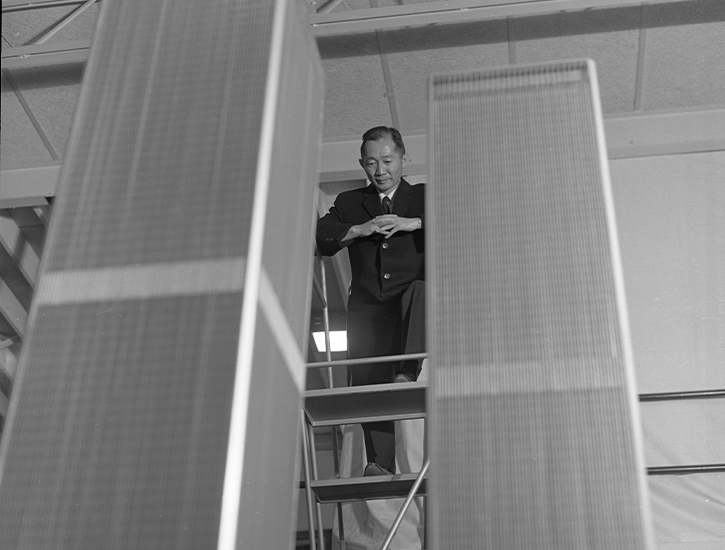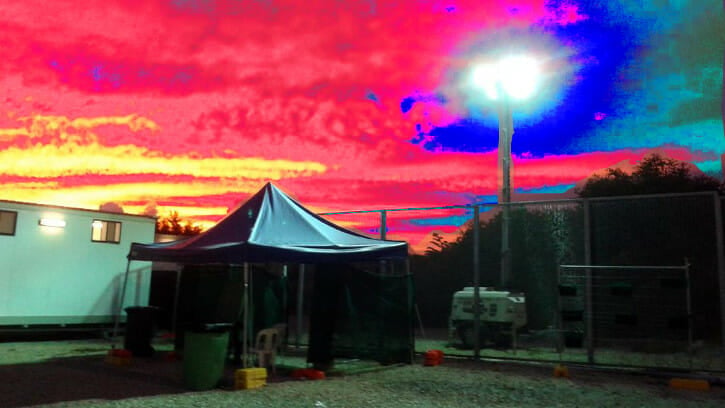【mor ning sex videos】Enter to watch online.The Architect’s (Auto)biographer
The Architect’s (Auto)biographer
Another airless scrap of culturalwriting Minoru Yamasaki with?a model of the World Trade Center |?Balthazar Korab Archive
Minoru Yamasaki with?a model of the World Trade Center |?Balthazar Korab Archive o
r
d
F
a
c
t
o
r
y
Sandfutureby Justin Beal. MIT Press, 256 pages.
Minoru Yamasaki has never enjoyed particularly great estimation in the annals of architectural history. His long career has become, for many, a caricature or outright failure, the stuffing wedged between the two disasters of the Pruitt-Igoe housing complex in St. Louis and the World Trade Center in New York. The dreadful ballast of this pair of publicly televised apocalypses—one of modernism, the other of something simultaneously more brazen and subtle—would likely sink any architect. His other works, such as Rainer Tower in Seattle, Princeton University’s Robertson and Peyton Halls, or the Northwest National Life Insurance Building in Minneapolis, are largely absent from surveys of twentieth century American architectural history. These projects, and Yamasaki himself, were quite heterodox with respect to their contemporaries, desiring to appear “friendly” or “gentle” during the high period of muscular and occasionally sullen Cold War modernism. Justin Beal’s Sandfuture, in its best moments, trains a sympathetic light on Yamasaki, considering his life?’and work as indispensable to any real understanding of his century, from modernism to “New Formalism” and beyond.
The MIT Press listing page for Sandfuturestayed open in a tab the entire time I was reading the book. Usually I don’t really bother with these sorts of things—the clipped vainglory of the press blurbs tends to be both grating and misleading—but here I found, in lieu of any other guide, a much-needed clarification of the books intent. After the fifth or sixth time referring to the page, I actually copied the salient points down on a sticky note:
- Minoru Yamasaki
- figure of the architect in literature and film
- transformations in the contemporary art market
- sick buildings
- social/political implications of how/for whom cities are built
This is accurate, if an oversimplification of both the book’s content and especially its presentation. Sandfuture, either by authorial design or overenthusiasm, doesn’t concern itself with creating an argument or presenting a thesis, much less providing answers. Of course, answers to the above are generally hard to find; besides, that’s not what we do anymore—we interrogate, we consider, we contemplate. Beal performs these tasks admirably, with the ambulatory langor of a flaneur and the perky excitement of an autodidact, inundating the reader with tangential facts and idle thoughts, woven up into aphoristic sections which flit from one subject to the next in accordance with a too-esoteric logic. Typical analysis is not a concern, and therefore Beal is free to indulge in an obsessive reading of these topics on his own terms. Considerations are not presented so much as they surface as a dialogic preoccupation before slowly subsiding into background noise. Reading along can produce a delirious feeling, not unlike trying to have a conversation while reading at the same time—a bewildering torrent of information that never really sticks.
The book seems to resist establishing a conversation between author and architect.
But this is ultimately the point: Sandfuture is not about any of the matters above. It’s not even about Minoru Yamasaki. It is about Justin Beal, New York City artist, Yale Architecture graduate, Hunter College adjunct lecturer. Rem Koolhaas (who appears in the acknowledgments at the end of the book, thanked for providing notes) endorses the book as a “hybrid biography,” but it is, at its core and on its sleeve, an autobiography (and at times, a self-obsessed one). Befitting Beal’s myriad interests, the scope of Sandfutureis its greatest asset, capable of imparting the rambling manuscript with an air of importance as it self-consciously holds court about the “real questions” of architecture. But dithering breadth is confused for vast purpose.
Yamasaki, when he does show up, is a bit of a ghost. What we see of him is a swirl of disconnected facts intimating a half-hearted Künstlerroman, or at his most lively, a cathected marionette. But more than this, the book seems to resist establishing a conversation between author and architect. Instead, they speak past each other—take, for example, a section describing a trip Beal took to Chandigarh, India, coming in at the end of a expository section on Yamasaki’s work and life in the 1950s, after the war:
En route, my path crossed Yamasaki’s at a number of points, including the Taj Mahal, Fatehpur Sikri, and Stone’s Embassy in New Delhi. By the time I got to Chandigarh, forty-seven years after Yamasaki, a city had grown up around the hulking buildings he had found so out of scale, and the city had responded with its own vernacular hybrid of modernism and pragmatism. One afternoon, after another day spent failing to gain access to the Secretariat building, I went to see a psychic who had been recommended by a friend in New York.
This section, which could have easily become a sort of rumination on Yamasaki’s travels, instead lurches—in the very next line!—from India to New York, back to Beal, alone, visiting a psychic. The smash cut device, while occasionally effective, reduces via repetition Yamasaki to a B-plot role in a book ostensibly about his life, or more accurately, an intermission inserted into Beal’s story solely to execute a scene change. Yamasaki is a technician, laboring away out of sight in order to make the book work. If you want a book about Yamasaki, go elsewhere. (Luckily, at the end of the book, Beal recommends Dale Allen Gyure’s monograph Minoru Yamasaki: Humanist Architecture for a Modernist World, among a few other sources.)
So—Sandfuture is about Beal, but what is Beal really concerned with? Yes, Pruitt-Igoe and World Trade both figure heavily; in sections which stay on track discussing these buildings, Beal shines. His depiction of Yamasaki as ensnared victim, hassled by a rogues gallery of tormentors which included the St. Louis Housing Authority, Port Authority employee Guy Tozzoli, and (eventually) Ada Louise Huxtable, renders the architect as an empathetic character. But again, like their creator, these buildings are relegated to subordinate elements, withering away entirely so Beal can wax poetic about other obsessions. Of all these, one dominates utterly: 432 Park. The superslender tower, designed by Rafael Vi?oly on“Billionaires Row” in Manhattan, serves as a foil for various musings on Fendi’s takeover of the fascist Palazzo della Civiltà Italiana, zoning and air rights, Aldo Rossi’s San Cataldo Cemetary ossuary, “symbolic value,” and J.G. Ballard’s High-Rise. It is also a column, a ruler, a stack of safe deposit boxes, the denuded corpse of architectural form, a way of keeping time. But primarily, 432 Park is a vexing torturer for Beal himself, looming over the city and his life like Satan astride Paris in Félicien Rops’ Satan Sowing Tares.
Sandfuture is just another airless scrap of culturalwriting, flensed utterly of anything of lasting importance.
Pruitt-Igoe, the World Trade Center, 432 Park: three buildings with complex, and one may say, epochal relevance to the time and place of their construction. And yet, in Sandfuture, one may forget their frankly earth-shattering importance. Pruitt-Igoe is treated respectfully, with Beal proceeding down the well-trodden (though correct!) path that Pruitt-Igoe was not a failure of modernism, as Charles Jencks famously said, but one of “social and political conditions.” The World Trade Tower, despite Beal’s laborious and illuminating account of its construction, seemingly vanished from the sky one day; 9/11 is here reduced to an inconvenience of trash and a National Guard-chaperoned trip to his lower Manhattan apartment, and elsewhere to a museum sale for a photo he took of the event in media res. No breath is wasted on how these towers’ destruction kickstarted a world-engine called the War on Terror which ate oil and ran on blood in the course of annihilating Iraq and Afghanistan, even as the timing of the book’s publication to correspond with 9/11’s twenty-year anniversary trades on such an association. Likewise, the deep pessimism with which Beal views 432 Park remains shallow, the product of an errantly excessive “global capitalism” which he is clear to disentangle from “authoritarian rule.”
The progressive pseudo-positions befitting apolitical critical theoryfor deep thoughtlongform essays and academic press fluff are checked off by rote: here we have necessary contrition over the past’s bloodthirsty racism (both against the Nisei Yamasaki and those who suffered in Pruitt-Igoe) and oversight (Rockefeller’s “catalytic bigness” vs. Jane Jacobs), here we have studied avoidance of existing inequality, an aberration to be excised. Having dealt soberly with the social and political issues, the critic may dust off their hands and return to the navel-gazing of culture writing, in which aesthetic opinions are like assholes, but some of those are worth more (namely, the ones with book deals).
Sandfuture is just another airless scrap of cultural writing, flensed utterly of anything of lasting importance, in which history is a Powerpoint of isolated vignettes, anecdote or feelings substitute for a political position, and a sort of over-tactile bewilderment at the status quo and its perverse, dizzying capacity to generate interesting relationships passes for philosophy or critique. This could have been a great book, but it remains encumbered by these potentially intractable problems. As it stands, it is a good one.


